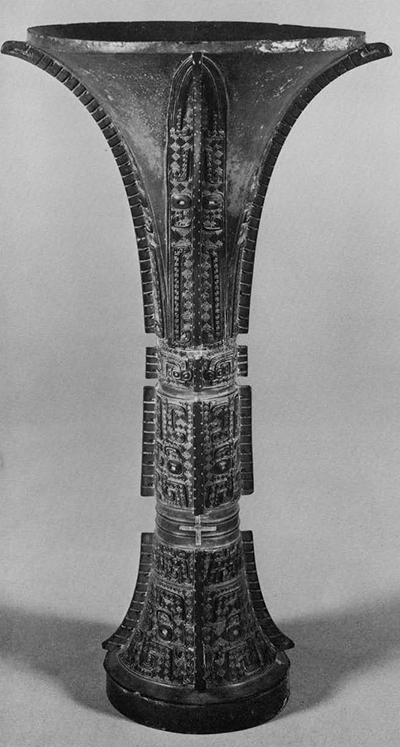
No evidence confirming the general use of bronze in Ancient China, now attested by archaeological remains, can so far be dated earlier than ca 1300 B.C. The most firmly dated context in which bronze was in general use was at Cheng-chou, Honan. The knowledge of sophisticated metalworking techniques and the ability to use them to produce complicated shapes and surface decor is evident in the earliest pieces. The hallmark of the Bronze Age in China is a group of bronze vessels which are thought to have been used for ritual ceremonies and were buried with the deceased of the aristocracy. Some believe that the knowledge of bronze casting was introduced from outside China because these early objects demonstrate such a high technical standard. At present an experimental stage similar to the Near Eastern example cannot be found in China. A developed copper age has not been discovered as yet, for example. The lack of evidence for a complete copper stage and the extraordinary sophistication of the ceramic industry suggest to some, notably N. Barnard, that the Chinese simply developed metal casting independent of metalworking (Barnard 1976).
Even though the concept of metalworking may not have been indigenous, few question several related factors which do seem to be native. Unique to China are many shapes in which the vessels are cast, as are many of the motifs and their disposition on the items. The bronze recipe has also been hailed as evidence for the spontaneous development of bronze in North China during the second millennium B.C. The purpose here is to examine the last of these proposals, the nature of the bronze mixture, not in an effort to prove the spontaneous generation of a metal industry, but to study the effect of that known combination of metals on the use and function of ritual bronze vessels in the Late Shang and Early Chou Dynasties (ca 1300—ca 950 B.C.).
The peculiarity of the Chinese bronze mix is its consistent high percentage of lead. Although lead was among the earliest metals known in the Near and Middle East, it was never very extensively employed (Lucas 1962:243). By contrast, even the earliest dated Chinese pieces show some lead content and the amount seems to increase slowly, but consistently, throughout the Bronze Age. Related to this question of recipe are the following: How are the vessels classed by use? Why did the Chou foundries, as was noted soon after the first excavations, eliminate almost entirely the wine-drinking vessels from their inventories at the end of the tenth century B.C. (Karlgren 1936:135-141; Willets 1958:86-87)? What were the drinking habits of the Shang and Chou aristocracy? What, if anything, has the bronze metallurgical industry to do with the change in composition of the metal or of vessel type? Why is lead so commonly used? Could wine and/or other liquids prepared for ritual actually be ingested if served or stored in such vessels? The drinking habits of the Shang are not known in any detail. One must piece together evidence from ancient texts, oracle graphs, and indicators in material culture-in this case, the bronze ritual vessels. The high lead content of Chinese bronze vessels suggests the likelihood of plumbism if actually used for storing or serving.
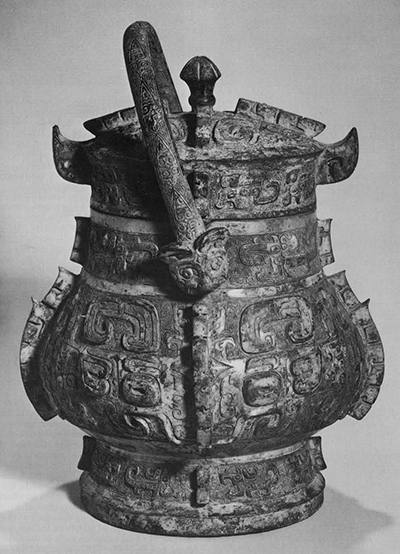
The region centered at Anyang, the district of the last Shang capital, displayed a higher degree of material culture than so far discovered in contemporary or near contemporary sites. Use of bronze-always an expensive product-marked the ascendancy of these city-dwellers. The earliest use of metal would seem to have been in weaponry. Although some have suggested that supplies of bronze were stored in the forms of troves of vessels which could be available for melting into raw material for more utilitarian objects should the political climate make it necessary (Watson 1972:88), this seems doubtful. The care and consistency with which the vessels were cast and the regularity of their inclusion in tombs of the aristocracy suggest a primary function in ritual. They must certainly have been status symbols of a sort as early as the Shang.
With the advent of the Chou in ca 1050 B.C., an effort was made to preserve Shang culture, at least until the end of the tenth century B.C. The Chou claimed ascendency to the Hsia, as did the Shang, and kept up many old Shang rites and habits. For example, the first Chou king, Wu Wang, enfeoffed members of the Shang royal family and gave them the metropolitan part of the old Shang domain in which to preserve their culture. His action was, at the same time, a means for political control. The area, Sung, was potentially dangerous and was therefore encircled by fiefdoms occupied by allies.
In material culture the shift from Shang to Chou was more subtle than the actual political break. Those changes, however, are especially telling as they reveal some of the earliest preferences of the new rulers (Poor 1970/3:1-8). In this sense they are considered to prefigure more radical changes that develop after the tenth century B.C. and point out the independent choices of the Chou soon after the fall of the old Shang capital. One such marked change in the bronze industry is the elimination of vessels used for serving or drinking wine from regular production (in the North) no later than 950 B.C. As these shapes, the tsun, the yu, the fang-i, the chin, the chueh, the chili, the ku, and the kuang form a group all associated with the imbibing or offering of wine, one would assume that the reason for their abrupt disappearance from production had something to do with their use. One should also ask if the composition of the other vessels changed as well.
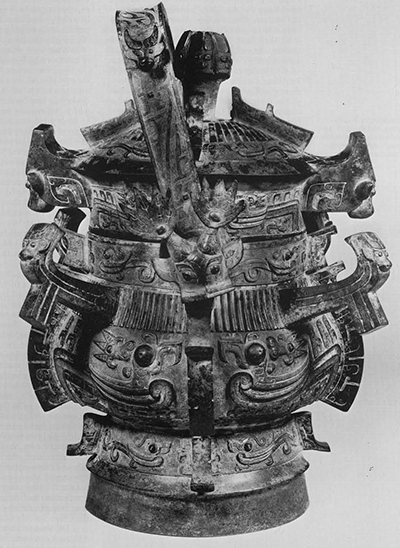
Information about the bronze materials, although not complete, must be viewed with respect to how and where the vessels were discovered. Data on archaeologically attested examples should be catalogued first, then materials not scientifically excavated may be compared to the first group. One must keep in mind the probability of local variations of the bronze composition. W. P. Yetts (1931:402) raises this point, but suspects that there were rough empirical standards. Unfortunately, data which would confirm regional variation in composition during the Shang is not yet available. The attested Shang materials used here are from the Anyang district, or are noted otherwise. The others correspond stylistically to those from Anyang. At present there is insufficient knowledge of ancient mines and mining for us to be able to relate composition and ore sources (Gettens 1969:46: Barnard 1976:48-51).
The studies of chemical composition of attested vessels show that the major constituents in the Shang and Early Chou alloy are copper, tin and lead. Ch’en Meng-chia (1954/7) assembled thirty-two Shang date samples: four ritual vessels and twenty-eight weapons. The sample showed the lowest percentage of lead at 0.62% and the highest at 11:58%. Unfortunately, the study does not differentiate the vessels from the weapons as the weapons would almost certainly be different from the vessels. This is clear in the Hsiao-t’un analyses where the percentage of lead is consistently higher among the weapons than the vessels.
The 44 excavated specimens from Hsiaot’un which have been published show the following results on the vessels:
| copper | tin | lead | total | |
| 1. Upright Vessel | 83.73 | 13.07 | 0.83 | 97.63 |
| 2. Edge of Vessel | 81.74 | 17.65 | 0.09 | 99.48 |
| 3. Fragment of Vessel | 79.12 | 20.32 | 0.05 | 99.49 |
The unaccounted for percentages are trace elements, metal lost through corrosion, or ones not determined in the testing process (Li Chi 1957: Table 2).
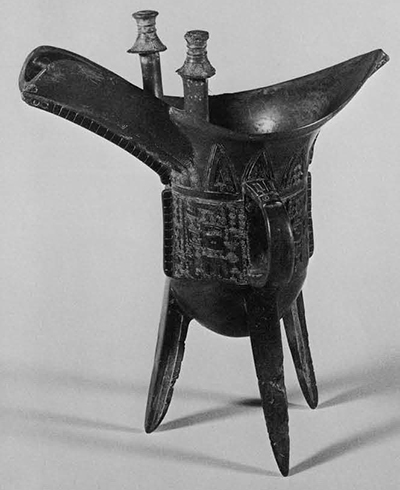
Among the weapons the range was somewhat different: 88 to 96% copper, 2 to 4% tin, and 1.05 to 2.59% lead. The figures show, as Barnard has pointed out (1953:187; 1976:19), that there was not an absolutely standardized composition for the Shang alloy, but besides copper and tin, lead was a regular part of the mix. The amount of lead is generally less than 3%. As Jung Keng reported (1958:123), in eight Shang vessels tested, 79.12 to 96.06% was copper, 1.83 to 20.32% tin and 0.05 to 2.59% lead. Similar results have issued from the British Museum Laboratory (Gettens 1969), and the Research Laboratory for Archaeology and the History of Art at Oxford (Gardner 1960:130-135), and by Sueji Umehara (1940:163-184).
In other materials tested the results are similar. On vessels now in the Royal Ontario Museum, and considered pre-Anyang in date, Barbara Stephen (1962:67) illustrated the results of x-ray fluorescence analyses. Samples taken from the bodies of these eight vessels yielded a percentage of from 28 to 1 part lead, and in several, lead is in excess of tin! It should be noted that all these types are thought to be serving or pouring vessels, and that they are similar in style to the bronze materials from Cheng-chou. It should also be noted that this report by Stephens and that by Gettens on the Freer Gallery Collection do explain the method of analysis, a thing which is not done in most reports, though it is to be presumed the wet method of chemical analysis was used (Chase 1974:148-185).
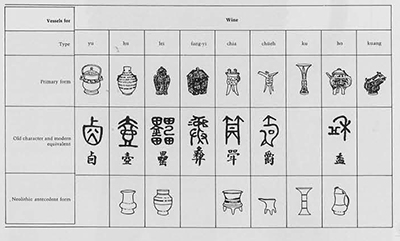
Of the Freer Gallery analyses the composition of the thirty vessels of certain Shang date used for the test reveals a composition of 77.2% copper, 13.5% tin and 7.2% lead on the average (Gettens 1969). Although the average percentage of lead drops to 4.2% in vessels dated Late Shang/Early Chou (11th century B.C.), by the Middle Chou (after ca 950 B.C.) a sharp increase to 12% is noticed. The figures reported by Jung Keng also suggest a rise in amount of lead used in the early Western Chou (ca 1050—ca 950 B.C.) to 21.54% in some pieces. However, because the percentage of lead is taken on materials which date from the Western Chou period (ca 1050-771 B.C.], it can be merely suspected that the amount of lead increased significantly, and immediately, in order to produce such a sharp rise in percent of lead in this case.
The evidence above confirms the regular use of unusually high lead content in bronze, but raises other related questions. Was the use of lead accidental? Was lead metallurgy, then, distinct from both copper and tin? Why include lead in the mix?
Enough was known about the metallurgical properties of lead in the early tenth century B.C. to gain the control necessary to increase the percentage. More telling, however, is the existence of vessels cast of almost pure lead, Bishop White (1956:176) catalogued a number of these dated in the early Chou; one chueh in the Freer Gallery, a Ii-ting and a chili in Holland consisting of 95.4% lead and 4.6% antimony. Six others are in the Hermitage Museum Collection in Norfolk, Virginia. Jo Shih (1956/1:pl. 8) reports several lead vessels that were found in Western Chou tombs at Loyang. They were cast in the shapes ku, tsun, chili, yu, ting, li and chueh. Although it may be surmised that these vessels served as ming-ch’i (Kuo Pao-chun 1963:47-48) or as cheap substitutes for the much prized bronze models, or as trial casts (Barnard 1953:pl. 34), the discovery that lead could be separated and controlled no later than the Early Chou cannot be ignored. One must assume that the metallurgical nature of lead was at least partially understood.
In support of this notion, Gettens (1969:9) suggests that the low silver content already noticeable in the Shang bronzes testifies to the existence of metallurgical knowledge of lead separate from that of both copper and tin. As lead is usually found in combination in an ore called galena (Pbs, lead sulfide) which often contains silver, the smelting of lead [for example in the Near East) was often undertaken for the sole purpose of recovering the silver content. Lead was an abundant by-product. E. A. Smith (1936:29-30) proposed that lead metallurgy predated that of tin and perhaps that of copper in the Near East, and that the Shang Chinese metallurgical industry was interested in the separation of lead and silver. However, in the Freer analyses, silver, next to iron, is the most abundant impurity.
The extraction of lead being a simple process, one needs only to roast it in contact with wood or charcoal, and “the sulfur component is burned off as sulfur dioxide; the lead oxide reacts with unconverted lead sulfide and carbon, and metallic lead is released.” (Gettens 1969:9]. This crude lead, which because of its high specific gravity (11.35) and liquidity collects at the bottom of the hearth, often contains silver. The two, lead and silver, were separated by the process of cupellation. However, this process was unknown in China before 600 B.C. There was little occasion to seek large quantities of lead except as required for the ternary alloy of bronze, and it is reasonably certain that the method of extraction was one aimed at releasing lead. The exact source of lead in China is unknown. But if galena was the Chinese ore known, silver should appear as a trace element in the mix., Silver does appear, but seldom more than 0.2% prior to the 6th century B.C. The smelting methods employed in ancient China seem almost exclusively applicable to ores comprising carbonates and oxides of copper, tin and lead. It is likely that the lead would have been found in an ore such as cerrussite (white lead ore, PbCO) (Barnard 1976:22 and 70). The accessibility of lead in North China (Amano Montonosuke 1953:236; Shih Chang-ju 1955:95-129), the relative ease with which it could be extracted, regardless of the composition of the ore, and the consistent, controlled use in bronze mixes strongly suggest that lead in its separated form was not rare in the Chinese foundries.
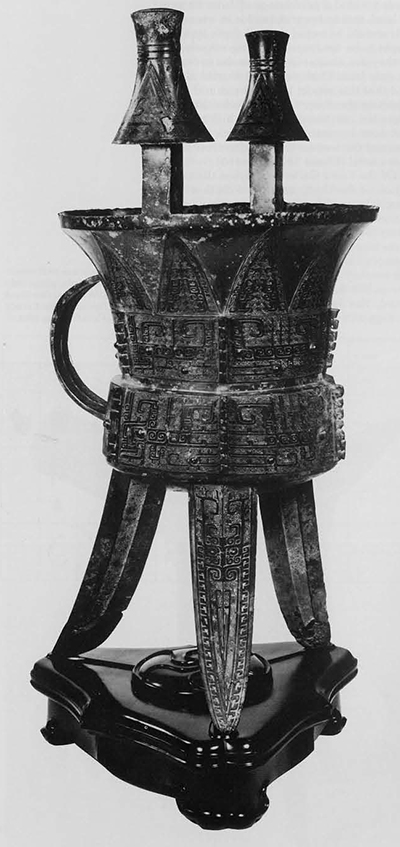
In fact, this evidence temptingly suggests that this early knowledge of the properties of lead was the basis for alchemical discovery. When reminded that the extension of life was the impetus for alchemical experimentation in China, the connection with metalworking and ancestor worship takes on a broader meaning.
Some have suggested that there is a distinct correlation between the use of the product and the relative proportion of metals in the alloy (Li Chi 1957:48). The vessels with the highest lead content were undeniably thought to have been grave substitutes. Those with the lowest content of lead would then he appropriate to more ostentatious grave settings. Often cited is the K’ao-kung-chi of the Chou-li, purported to be of Chou Dynasty origin. The six recipes for proportions of copper and tin suggest differentiation dependent on product. For cauldrons, 5 to 1; for axes, 4 to 1; for halberds and spears, 3 to 1; for swords and knives, 2 to 1; for erasing knives and arrows, 3 to 2; for mirrors, 1 to 1 (Gettens 1961:22). This would suggest that the vessels were the most highly regarded.
But the extracted lead probably served purposes other than saving the more costly copper and tin. Although it is still not known exactly how the lead was introduced into the alloy, it is certain that the melting point of the mix was lowered by such addition, that it produced a cleaner cast, and that it made for easier finishing operations, such as removal of ridges and flaws, and for simpler final burnishing. Lead causes this in any mixture. Since the molten material could flow more easily and shrink less rapidly, the addition of lead allowed for the use of more complicated and intricate designs. And even though the exact proportions of the metal were not apparently standardized, and the K’ao-kung-chi passage quoted above cannot be precisely borne out in analyses, certainly the properties of lead described were known and desired. Lead was consciously added in a relatively consistent proportion in Shang and would be included often in higher proportion during the Chou Dynasty, though regional preferences must be considered (Gettens 1969:45).
Together with the increased knowledge of a metallurgical nature which affected the making of the vessels, other alterations are noticeable. Most studies of the ancient Chinese bronzes remark that during the Shang they were used for sacrimonial rituals. Inscriptions on the vessels further suggest that they were made in honor of particular ancestors whose memories were perpetuated by ritual observance. Ancestors and cosmic beings were consulted about important matters of domestic concern. The Shang vessels, when inscribed, record the name of the ancestor and occasionally the donor. Early in the Chou period inscriptions changed; they grew longer and included not only the name of the ancestor and the donor, but also the circumstances that led to the casting. The uses of the vessels were presumably diversified as well to include such secular purposes as gift-giving in payment for services rendered.
Although the Chou foundries continued the Shang canons of bronze decor to a great extent, Chou taste demanded the introduction of new and alteration of old motifs (Figures 2 and 3]. As the style of decor slowly shifted from a tectonic to a more plastic expression, so too did the composition of bronze change. One should also postulate a change in the use of the vessels. The most noticeable evidence for such a change in use, and presumably in ritual, is the elimination of the wine containers after the first century of Chou rule. Sacrifice to the ancestors involved the offering of food and wine. Because many of the bronze vessels had counterparts in utilitarian clay models, their use has been deduced. They were used to cook, store and serve offerings of grain and meat and to heat, pour and drink wine or to mix it with water.
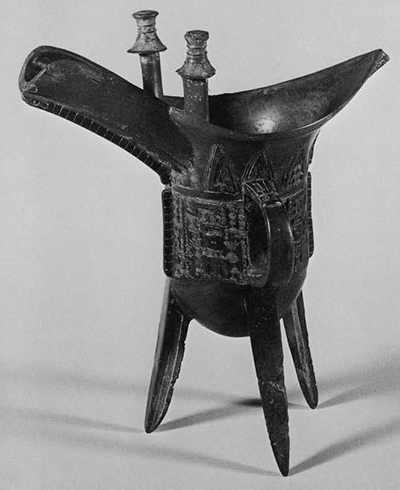
An immediate problem with the use of the bronze wine containers was the likelihood of chronic plumbism among the users and especially the artisans who heated and poured the alloy. It is well established that metallic lead, both as such and when alloyed with other metals such as tin, is comparatively soluble. Even some, but not all, drinking waters dissolve some lead. Acid foods, especially acid fruits and vegetables, and tea and vinegar when stored in leaden vessels are contaminated. Even more active are the alcohols. Chinese wine was made by fermenting grain, either millet or rice (Wu Tze 1953: 160). An advantage of using lead in vessels used for brewing is that it gives a sweetish taste to the liquid and poisons microorganisms that cause souring. Lead will stop fermentation as well. However, continued use of containers releasing lead in the range of 7 to 20 ppm [parts per million) would give rise to chronic lead poisoning (Ceramic Industry 1970). If the Shang were using the bronze vessels to store and serve the wine, they were in danger of contracting either acute or chronic plumbism, Symptoms are nonspecific: decreasing appetite, fatigue, headache, drowsiness, and stupor. Further ingestion leads to irreversible injury such as brain damage and blindness, sterility and, in some cases, even death. The symptoms are similar to alcoholism.
The effect of lead content in house paints, ceramic glazes, water pipes, pewter dinner ware and a variety of household goods was studied first by R. Kobert (1906-1909). Others have applied his findings to the use of such items in cultures including Ancient Rome (Filfillan 1965) and Early America (McCord 1953). For instance, The Massachusetts Bay Colony forbade rum distillation in leaded stills in an effort to prevent “dry gripes.” The American colonists were in danger both from contaminated alcohol and from continued use of household pewter but no one, including the physicians, identified widespread “dry gripes” with the leaden containers (McCord 1953: 577). The case may have been similar among the Chinese aristocrats; they were concerned with elimination of the symptoms identified as “drunkenness,” and may not have located the cause.
There is some documentary evidence which alleges excessive drinking of alcohol and drunkenness in Shang China. For instance, the drinking habits of the late kings of the Shang Dynasty, especially of the last King Chou Hsin who “. .. went quite astray, and was abandoned to the practice of drunkenness,” were recorded in Book XV of the Shu Ching (Legge tr:470-471) and declared by the Chou as unacceptable behavior for a person in a position of authority. Although of questionable date, emphasis on the evils of drinking was apparent. In Book X of the same, “The Announcement about Drunkenness,” the use of spirits was limited by the Chou t0 important sacrifices. The causes assigned for the ruin of virtue and prosperity of the State by the Shang were the “Terrors of Heaven” and “excessive indulgence in the spirits.” (Legge tr:464-473). The downfall of the Shang was at least in part attributed to overindulgence in drink. But the symptoms could have been due to lead present in even small portions of liquid taken from bronze ritual vessels. Although these edicts are of uncertain date they do reflect a common practice in China, that of legitimizing one’s position by denigrating the conquered (Schurman 1971:29). Confucian ethics necessitated moderation, especially with regard to wine. Excessive drinking, or the symptoms associated with it, was a commonly noted cause of past defeats or downfall such as that of the Shang. Whatever the exact situation, or interpretation of the texts, one actual effect of the change in ruling house was the elimination of drinking vessels from the usual repertoire of ritual implements. The implied conclusion is that the Chou ritual limited or eliminated the use of wine. As the use of wine was controlled, lead was increased in the recipe, perhaps by coincidence.
Evidence about ceremony and vessel types used for wine which can be found in oracle records suggests that the liquid was not necessarily ingested. The oracle graphs 
 and
and  are used as verbs, meaning, “to offer libation, to anoint or sprinkle” at sacrifice or ceremonial honoring the ancestors (Lo Chen-yu 1910:1a). Each word contains the amphora sign
are used as verbs, meaning, “to offer libation, to anoint or sprinkle” at sacrifice or ceremonial honoring the ancestors (Lo Chen-yu 1910:1a). Each word contains the amphora sign  and the radical
and the radical  for fluid, thought to be the components of the modern form chiu [
for fluid, thought to be the components of the modern form chiu [ ]. The forms
]. The forms  and
and  , although tempting to interpret as pictographs of actual winemaking, appear in inscriptions in the same position as
, although tempting to interpret as pictographs of actual winemaking, appear in inscriptions in the same position as  and seem to function in the same way and with similar meaning (Wu Tze 1953:159-163). The well-known oracle-bone graphs which delineate and name the wine vessels such as chueh
and seem to function in the same way and with similar meaning (Wu Tze 1953:159-163). The well-known oracle-bone graphs which delineate and name the wine vessels such as chueh  (
(  Figure 4) and chia (
Figure 4) and chia ( 
 Figure 6) do not seem to specifically suggest wine drinking in the inscriptions. The graphs designate libation or sprinkling at sacrifice and are used interchangeably. There is no doubt that those shapes are associated with ceremony involving libation and sacrifice from this early date. The chueh and the chia served as receptacles for the liquids used in libations or ablutions. Care seems to be taken to avoid any suggestion of drinking, Libations involved pouring of liquids in honor of the deities, ablutions involved sprinkling of the liquid on ancestral tablets. The contaminated liquids were perhaps merely contained in the vessels during ritual where pouring and sprinkling of wine in honor of the ancestors was appropriate. Perhaps the Shang knew the dangers of drinking from these vessels.
Figure 6) do not seem to specifically suggest wine drinking in the inscriptions. The graphs designate libation or sprinkling at sacrifice and are used interchangeably. There is no doubt that those shapes are associated with ceremony involving libation and sacrifice from this early date. The chueh and the chia served as receptacles for the liquids used in libations or ablutions. Care seems to be taken to avoid any suggestion of drinking, Libations involved pouring of liquids in honor of the deities, ablutions involved sprinkling of the liquid on ancestral tablets. The contaminated liquids were perhaps merely contained in the vessels during ritual where pouring and sprinkling of wine in honor of the ancestors was appropriate. Perhaps the Shang knew the dangers of drinking from these vessels.
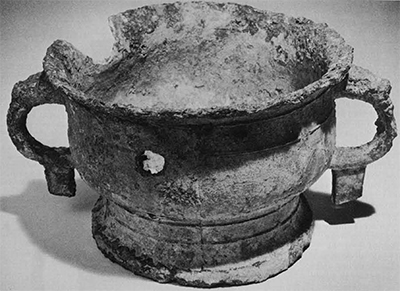
There is no way of knowing absolutely if the Shang drank out of the vessels after the ritual. They may have used ceramic containers to hold the wine for drinking. However, if the bones from the tombs at Anyang show lead content, it could be concluded that they drank the contaminated liquid and that they also may have died from plumbism. But the Early Chou kings may simply have wished to eliminate drinking, or the part of the ceremony which led to it, at court ritual as a show of good government and control. Even if they knew of the danger of drinking from heavily leaden vessels, they seem not to have connected it with actual sickness other than drunkenness. They eliminated the practice of drinking alcohol at ritual and with it the necessity for that special group of bronze vessels.
In sum, the use and function of the ritual vessels cast in shapes which suggest containment of liquid or other sacrificial offerings may be connected to questions of alloy content. The Chinese metalworkers had sophisticated knowledge of the properties of metals. This would certainly be true of lead. The peculiarity of the Chinese bronze recipe could have had serious repercussions on the health of the users should they ingest any contents from the vessels. The oracle inscriptions, however, suggest that the liquids were sprinkled or poured as offerings to the ancestors. The elimination of the wine vessels suggests an attempt to eliminate problems whether caused by or suggested by their presence: the symptoms of drunkenness and/or plumbism. Their disappearance was certainly an expression of control and probably a clear statement against excess, perhaps specifically against drinking.
